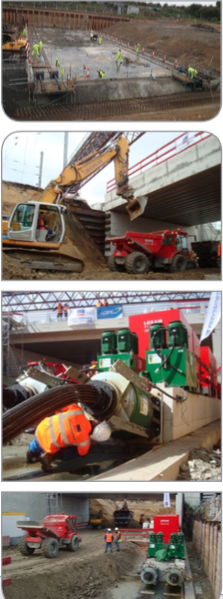
Highways Agency
Principal Contractor
Costain
Engineer
Jacobs
Works Commenced
August 2015 (Guide raft)
December 2015 (Slide)
The road improvements at the access to the Port of Immingham in Lincolnshire required a new route to be formed under the railway that feeds the port – one of the busiest stretches in the UK. Interruption had to be kept to a minimum and the Highways Agency had agreed with Network Rail to build the underpass next to the tracks and then slide it into place during a blockade at Christmas 2015. The box measured 39x18x11m high and weighed approximately 3000 tonnes.
The sliding method selected was Freyssinet’s Autofoncage® method. In this, the concrete box literally floats on a bed of bentonite (modified liquid clay) while horizontal cables pull the structure across the line of the railway. The cable arrangement is ingenious as it can all be set up prior to the blockade. In other words, all the preparation is done to the side of the live railway, nothing needs to be laid or installed across the rail embankment.
The secret is the construction of the guide raft, a 250mm thick slab of similar plan size to the box being slid. This acts as the reaction point for launching the box and it mobilises soil resistance with help from an end reaction wall. The passive end of the cables is anchored into the end of the guide slab that is closest to the railway.
On top of the guide raft the concrete box is constructed and the interface between them is greased and covered in plastic sheeting, as this will become the sliding surface on launch day. The active ends of the cables are embedded in the base slab of the box that is remote from the railway. Consequently, when the stressing jacks are attached and the cable is shortened by the stressing process, the rear of the box is ‘catapulted’ towards the railway. The structures are sized and positioned so that when the active ends of the cables reach the passive ends, the box has been launched across the railway.
The embankment has to be excavated immediately prior to the sliding, but rather than removing sufficient material to allow the box clear passage, the excavation is left deliberately too narrow. As the box advances, the lower corners of the cut are locally excavated by mini excavators as the wall of the box chisels into the soil. As a result, the total quantity of muck to shift, and replace, is greatly reduced. The box, consequently, slides against soil on its base and the majority of both sides.
The programme at Immingham has the excavation on Christmas Eve, the slide on Christmas Day and the backfilling/reinstatement on Boxing Day.
Freyssinet Ltd. Innovation House, Euston Way, Town Centre, Telford, Shropshire, TF3 4LT Phone +44 (0) 1952 201901 Fax +44 (0) 1952 201753 Email rail@freyssinet.co.uk
